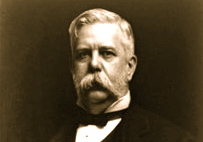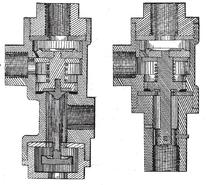George Westinghouse

Westinghouse
Radio broadcasting during the era of recovery from the Great Depression was a critical factor in that recovery. The early Radio networks were recovering as well. Cash-strapped and low on capital, the networks of the era turned more and more to independent programming producers to meet the Nation’s voracious appetite for new and unique Radio entertainment. The mid-1930s found more networks extending their programming around the clock, commencing as early as 5:00 a.m. and broadcasting as late as midnight to 1:00 a.m. in most metropolitan areas of the country. The increase in demand combined with longer and more regular programming schedules presented even greater opportunities to a growing number of independent transcription houses. The mid-1930’s also saw a great deal of consolidation in transcription houses–on the east and west coasts, in particular. Here’s a representative list of the independent and network transcription houses throughout 1934.
 George Westinghouse, Jr (October 6, 1846 – March 12, 1914)
George Westinghouse, Jr (October 6, 1846 – March 12, 1914)
He was an American entrepreneur and engineer who invented the railway air brake and was a pioneer of the electrical industry. Westinghouse was one of Thomas Edison‘s main rivals in the early implementation of the American electricity system. Westinghouse’s system, which used alternating current based on the extensive research by Nikola Tesla, ultimately prevailed over Edison’s insistence on direct current. In 1911, Westinghouse received the AIEE’sEdison Medal “For meritorious achievement in connection with the development of the alternating current system.”
Early years
He was born in Central Bridge, NY in 1846. He was the son of a machine shop owner and was talented at machinery and business. At the age of fifteen, as the Civil War broke out, he enlisted in the New York National Guard until his parents urged him to return home. Two years later in 1863, he persuaded his parents to allow him to re-enlist and joined the New York Cavalry. In December 1864 he resigned from the Army to join the Navy, serving as Acting Third Assistant Engineer on the USS Muscoota through the end of the war. In 1865 he returned to his family in Schenectady and enrolled at nearby Union College. However, he lost interest in the curriculum and dropped out in his first term there.
Westinghouse was 19 years old when he created his first invention, the rotary steam engine. He also devised the Westinghouse Farm Engine. At age 21 he invented a “car replacer,” a device to guide derailed railroad cars back onto the tracks, and a reversible frog, a device used with a railroad switch to guide trains onto one of two tracks.
In 1867 Westinghouse met and soon married Marguerite Erskine Walker. In their nearly forty-seven years of marriage they had one son, George Westighouse 3rd. The couple made their first home in Pittsburgh, Pennsylvania. They later acquired houses in Lenox, Massachusetts and in Washington, District of Columbia. Mrs. Westinghouse died only a few months after her husband.
At about this time he witnessed a train wreck where two engineers saw one another, but were unable to stop their trains in time using the existing brakes. Brakemen ran from car to car, on catwalks atop the cars, applying the brakes manually on each car.
 Westinghouse Steam and Air Brakes (U.S. Patent 144,006)
Westinghouse Steam and Air Brakes (U.S. Patent 144,006)
In 1869 at age 22 he invented a railroad braking system using compressed air. The Westinghouse system used a compressor on the locomotive, a reservoir and a special valve on each car, and a single pipe running the length of the train (with flexible connections) which both refilled the reservoirs and controlled the brakes, applying and releasing the brakes on all cars simultaneously. It is a failsafe system, in that any rupture or disconnection in the train pipe will apply the brakes throughout the train. It was patented by Westinghouse on March 5, 1872. The Westinghouse Air Brake Company (WABCO) was subsequently organized to manufacture and sell Westinghouse’s invention. It was in time nearly universally adopted. Modern trains use brakes in various forms based on this design.
Westinghouse pursued many improvements in railway signals (then using oil lamps) and in 1881 he founded the Union Switch and Signal Company to manufacture his signaling and switching inventions.

